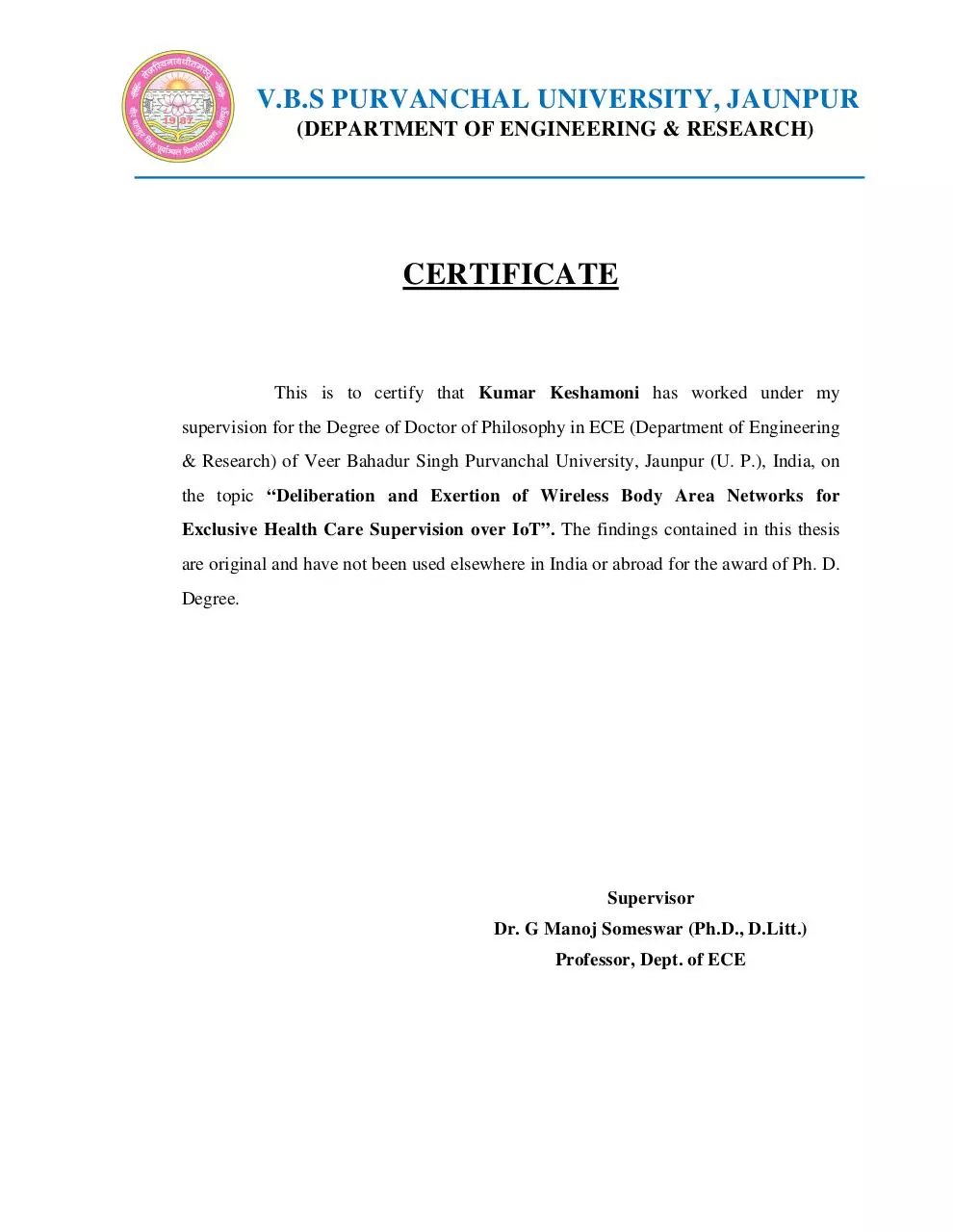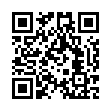Ph D Kumar Safe (PDF)
File information
Title: MergedFile
Author: Reyansh Goud
This PDF 1.4 document has been generated by PDFCreator 2.5.2.5233 / 3-Heights(TM) PDF Merge Split API 4.9.17.0 (http://www.pdf-tools.com), and has been sent on pdf-archive.com on 29/09/2017 at 16:29, from IP address 157.48.x.x.
The current document download page has been viewed 426 times.
File size: 5.59 MB (153 pages).
Privacy: public file





File preview
Deliberation and Exertion of Wireless Body
Area Networks for Exclusive Health Care
Supervision over IoT
Thesis
Submitted To The
VEER BAHADUR SINGH PURVANCHAL
UNIVERSITY, JAUNPUR (U.P.) India
For the award of
Doctor of Philosophy
Degree in ECE
SUBMITTED BY:
Kumar Keshamoni
Enrolment NO. PU 2014/6225
Under the supervision of
Dr. G Manoj Someswar (Ph.D., D.Litt.)
Professor, Dept. Of ECE
JAUNPUR, UP, India
2017
V.B.S PURVANCHAL UNIVERSITY, JAUNPUR
(DEPARTMENT OF ENGINEERING & RESEARCH)
CERTIFICATE
This is to certify that Kumar Keshamoni has worked under my
supervision for the Degree of Doctor of Philosophy in ECE (Department of Engineering
& Research) of Veer Bahadur Singh Purvanchal University, Jaunpur (U. P.), India, on
the topic “Deliberation and Exertion of Wireless Body Area Networks for
Exclusive Health Care Supervision over IoT”. The findings contained in this thesis
are original and have not been used elsewhere in India or abroad for the award of Ph. D.
Degree.
Supervisor
Dr. G Manoj Someswar (Ph.D., D.Litt.)
Professor, Dept. of ECE
UNDERTAKING FORM OF THE CANDIDATE
I hereby declare that the work incorporated in the present thesis entitled
“Deliberation and Exertion of Wireless Body Area Networks for Exclusive Health
Care Supervision over IoT” is my own work and is original. This work (in part or in
full) has not been submitted to any university for the award of a degree or diploma.
Signature of the Candidate
(Kumar Keshamoni)
CANDIDATE’S DECLARATION
I, Kumar Keshamoni, certify that the work embodied in this Ph.D. thesis is my
own bonafide work carried out by me under the supervision of Dr. G Manoj Someswar
at Department of Electronics & Communication Engineering, Veer Bahadur Singh
Purvanchal University, Jaunpur. The matter embodies in the Ph.D. thesis has not been
submitted for the award of any degree/diploma.
I declare that I have faithfully acknowledged, given credit to end referred to the
research workers wherever their works have been cited in the text and the body of the
thesis. I further certified that I have not willfully lifted up some other’s work, Para, text,
data, results etc. reported in the journal, books, magazines, reports, dissertations and
thesis etc. or available at web-sited and included them in this Ph.D. thesis and cited as my
own work.
Signature of the Candidate
(Kumar Keshamoni)
ACKNOWLEDGEMENT
At the outset, it is my privilege to express my sincere gratitude and feel indebted
to my thesis supervisor Dr. G Manoj Someswar (Ph.D., D.Litt.), Professor, Department
of Electronics & Communication Engineering, for suggesting me the problem and his
keen interest, invaluable help and continuous encouragement during my entire research
work. His untiring patience, constructive criticism and constant motivation, enabled me
to do this work so as to reach a stage of completeness. Whenever I fumbled in darkness
of confusion and dilemma, enlightenment came from his suggestions, criticism and
guidance and clearing the horizons for me. Apart from thesis matters his interests in
leading a healthy and disciplined life also influenced me.
I am grateful to Dr. Mayank Tripathi (Ph.D., D.Litt.), Professor & Head, Department
of Electronics & Communication Engineering, for his perpetual inspiration and
inimitable teaching as a source of infinite acumen. He has always been a source of
encouragement for me during my entire work.
I gratefully acknowledge the encouragement, the unceasing care given by Dr. Harish
Chandra Tripathi, Dr. Eswar Rai Upadhayay of Associate Professor, Department of
Electronics & Communication Engineering, U N S Institute of Engineering &
Technology, Jaunpur. I am highly obliged to all of the above mentioned teachers for their
unending help, support and love towards me and my work.
I extend my sincere thanks to all the subjects of different Colleges and Universities for
extending all the help during the collection of data. Their enthusiastic cooperation and
support is priceless, without their support I’ll not be able to complete my work.
Kumar Keshamoni
ABSTRACT
The net of Things (IoT) makes sensible objects the last word building blocks
within the development of cyber physical sensible pervasive frameworks. The IoT
incorporates a type of application domains, as well as health care. The IoT revolution
is redesigning fashionable health care with promising technological, economic, and
social prospects. This thesis advances in IoT-based health care technologies and
Body-area networks (BANs) are wireless detector networks (WSNs). This thesis
analyzes distinct IoT security and privacy options, as well as security necessities,
threat models, and attack taxonomies from the health care perspective. Body-area
networks (BANs) are wireless detector networks (WSNs) that operate in shut
proximity to the human body, getting used for instance for distributed wireless
medical body sensors. Current implementations of BANs use standardized
frequencies (RF) technologies like IEEE 802.15.4, and don't account the
characteristics of the body channel, e.g. sturdy attenuation of high frequency radio
waves. In order to supply high responsible additionally as energy potency whereas
communicating near the flesh, a replacement technology known as body-coupled
communication (BCC) was developed. As it uses the flesh as channel, it doesn't suffer
from shadowing and allows economical and reliable digital communication between
nodes in shut contact with the flesh. As many applications still need transmission
some knowledge few meters from the flesh, it's essential to even have RF capabilities
during a BCC-BSN. During this thesis we have a tendency to propose replacement
BAN node architecture wherever all nodes have each a BCC and RF transceiver.
Tendency to propose a protocol that allows the cooperation between the 2
technologies. A Tendency to gift the hardware and software system implementation
and illustrate our conception with measurement results.
This thesis proposes AN intelligent cooperative security model to attenuate security
risk. We show that our dual technology solution is more efficient and reliable than
classical RF solutions for BANs. This paper provides energetic security algorithm for
sensing devices and multiple applications. Industries such as relevant to medicine and
sport can get benefits means in plenty from the wireless body area network projects.
By means of these sensor devices any one can successfully know the heartbeat, level
i
of the glucose, and blood pressure of the patient. We can predict heart attack,
diabetes, cancer and many other diseases without much of a difficulty using Wireless
body area network concepts. The Internet of Things (IoT) makes sensible objects the
last word building blocks within the development of cyber-physical sensible pervasive
frameworks. The IoT incorporates a type of application domains, including health
care. The IoT revolution is redesigning fashionable health care with promising
technological, economic, and social prospects.
ii
LIST OF FIGURES
Figure 1.1 -The proposed typical structure of the health IoT system
7
Figure 2.1 - Block diagram of a BN powered by energy harvesting
13
Figure 2.2 - Energy harvesters in the human environment
15
Figure 2.3 - Examples of predictable energy harvesting sources
16
Figure 2.4 - Examples of unpredictable energy harvesting sources
17
Figure 2.5 - Examples artificial energy harvesting sources
18
Figure 2.6 - Architectures of systems powered by energy harvesting: a) HarvestUse Architecture, and b) Harvest-Store-Use Architecture
Figure 2.7 - Main characteristics of energy storage units
Figure 2.8 - Relation between IEEE 802.15.6 and the others types of wireless
networks
Figure 2.9 - Illustration of the heterogeneity of the BNs in the BANs
Figure 2.10 - Medical WBANs: data transmission rates and average power
consumption, compared to other wireless technologies.
Figure 2.11 - Distribution of power consumption when a sampled signal is
transmitted by an ECG
Figure 2.12 - Power consumption of some operation modes in a wireless sensor
19
21
22
22
24
25
26
Figure 2.13 - BNs connected to various energy harvesters in the human body:
(a) heartbeats (predictable source), (b) environmental light and temperature
difference (unpredictable sources) and (c) transcutaneous energy transfer
28
(artificial source)
Figure 2.14 - System performance and energy consumption correlation in ENO
and ENO-MAX states
Figure 2.15 - Classification of MAC protocols
29
31
Figure 2.16 - Contention-free multiple-access methods: (a) TDMA, (b) FDMA,
and (c) CDMA. Each BN in the network is represented by a different color and
number
iii
32
Figure 2.17 - Timing diagram of Aloha pure and slotted
33
Figure 2.18 – Slotted CSMA, state transition diagram
38
Figure 2.19 - Slotted CSMA, transmission timings
38
Figure 2.20 – Unslotted CSMA, state transition diagram
39
Figure 2.21 - Unslotted CSMA, flowchart of the backoff mechanism
40
Figure 2.22 - ID-polling, state transition diagram
41
Figure 2.23 - ID-polling, transmission timings
42
Figure 2.24 - Probabilistic polling, pc updating algorithm
43
Figure 2.25 - Mathematical representation AIMD, MIMD, AIAD, and MIAD
techniques for probabilistic polling protocol
Figure 2.26 - Comparison of AIMD, MIMD, AIAD, and MIAD techniques for
probabilistic polling (pUn = 0.01 ,pmi = 2, nd pmd = 0.5)
Figure 3.1- Health monitoring system network architecture
Figure 3.2 - Prototype WBAN sensors.
From left to right: eActiS with
electrodes, ActiS
44
45
53
57
Figure 3.3 - Functional block diagram of Tmote Sky platform
58
Figure 3.4 - Tmote Sky wireless platforms
59
Figure 3.5 - Functional block diagram of the MSP430F1611
59
Figure 3.6 - ISPM block diagram
62
Figure 3.7 - ActiS sensor node – Tmote Sky with ISPM motion sensing
daughter card
63
Figure 3.8 - ADXL202 PWM descriptions [ADXL202]
64
Figure 3.9 - TinyOS timer interfaces
66
Figure 3.10 - TinyOS TimerC configuration diagram
67
Figure 4.1 - Healthcare trends
74
Figure 4.2 - IoT health care network (IoThNet) issues
76
Figure 4.3 - A conceptual diagram of IoT-based ubiquitous healthcare solutions.
77
Figure 4.4 - Remote monitoring in wearables and personalized health care.
78
iv
Download Ph D Kumar-Safe
Ph_D_Kumar-Safe .pdf (PDF, 5.59 MB)
Download PDF
Share this file on social networks
Link to this page
Permanent link
Use the permanent link to the download page to share your document on Facebook, Twitter, LinkedIn, or directly with a contact by e-Mail, Messenger, Whatsapp, Line..
Short link
Use the short link to share your document on Twitter or by text message (SMS)
HTML Code
Copy the following HTML code to share your document on a Website or Blog
QR Code to this page

This file has been shared publicly by a user of PDF Archive.
Document ID: 0000679640.